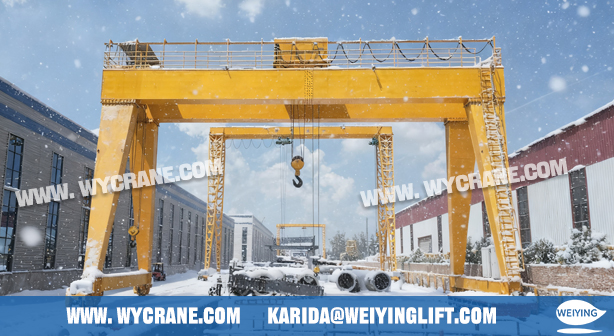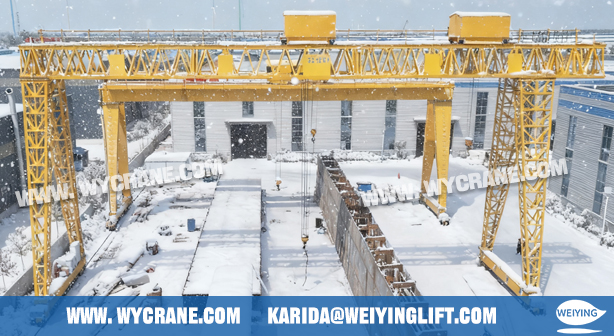Operating gantry cranes in the harsh conditions of winter is one of the greatest challenges for heavy industry. In regions such as Russia, Northern Europe, and Canada, cranes are often exposed to temperatures below –40°C, strong winds exceeding 20 m/s, and persistent snow or freezing rain. Under such conditions, the performance and safety of a gantry crane can be significantly compromised. Metal components lose ductility, hydraulic systems slow down, electrical circuits become unstable, and visibility drops sharply. Without proper adaptation, these factors can lead to costly downtime — or worse, serious accidents.
To ensure both reliability and operator safety, every aspect of the crane and its environment must be considered: material selection, mechanical design, maintenance strategy, and operational behavior. Let’s take a closer look at how extreme weather affects gantry cranes and what practical measures can keep them performing safely in subzero environments.
 |
 |
When the ambient temperature falls below freezing, the physical properties of steel change dramatically. At –20°C, the toughness of standard carbon steel begins to drop; at –40°C, it can become brittle and crack under sudden impact. For a gantry crane, this brittleness affects load-bearing structures, weld seams, bolts, and trolley rails. Even a minor shock — such as abrupt braking or swinging loads — can cause microfractures that gradually propagate into serious damage.
To counter this, cranes designed for high-latitude operation are constructed from low-alloy, cold-resistant steel. These materials maintain both strength and flexibility even in subzero conditions. Operators in cold regions should also conduct frequent non-destructive testing (NDT) on welds and joints, especially after sudden temperature drops or heavy use in freezing weather.
The cold also affects hydraulic and lubrication systems, which depend on fluid movement for smooth control. As the temperature decreases, conventional hydraulic oil thickens, and its viscosity may increase by several times. This leads to delayed valve response, sluggish cylinder movement, or even hydraulic lock — a condition where oil becomes too dense to circulate. The solution is to switch to low-temperature hydraulic oil rated for –40°C and preheat the system before work. Many modern gantry cranes use oil circulation heaters and hydraulic warm-up loops to ensure consistent performance during long outdoor shifts.
Electrical systems suffer as well. In cold climates, battery capacity can fall by 40–50%, making it difficult to start motors or operate control systems. Insulation on standard PVC wiring becomes rigid and may crack, allowing moisture to enter and cause short circuits. For this reason, cranes working in severe winter should use cold-resistant silicone or rubber cables, heated control cabinets, and anti-condensation devices to prevent frost inside electrical boxes.
While freezing temperatures degrade material performance, wind is the most immediate threat to crane stability. A gantry crane’s large, flat structure acts as a giant sail. Even moderate winds of Force 4 on the Beaufort scale (20–28 km/h) can cause noticeable sway across long spans, while winds above Force 6 (40–50 km/h) can move suspended loads dangerously off-center.
When wind gusts exceed 50 km/h (Force 7), the entire crane structure experiences uneven lateral forces. The main girder and trolley may vibrate, increasing fatigue on the end beams and rail connections. Loads begin to oscillate like pendulums, creating unpredictable stresses on the hoist wire and potentially colliding with nearby structures or personnel.
To minimize this risk, gantry cranes should be fitted with anemometers to monitor wind speeds in real time, with automatic alarms at 10–12 m/s (Force 6). When these limits are reached, operators must halt all lifting operations immediately and secure the crane using windproof rail clamps or storm anchors. In high-wind areas, such as coastal shipyards or open industrial parks, the crane should also be designed with aerodynamic end beams and reinforced guide wheels to resist lateral pressure.
Operationally, lifting capacity should be reduced by 20–30% when winds reach 8–10 m/s (Force 5). Long or wide loads — such as beams, plates, or containers — must never be lifted during gusty conditions, as their wind-catching surface area increases the swinging amplitude exponentially. In addition, clear communication zones should be established so that operators and ground personnel can coordinate movements safely, even in noisy or turbulent conditions.
Snow and ice pose another serious hazard during winter operations. A layer of 10 cm of compacted snow on a 30-meter gantry girder can add more than one ton of additional static weight, putting unexpected stress on the crane’s structure. Ice buildup can also interfere with wheel traction, jam limit switches, and increase the risk of derailment.
When freezing rain occurs, water can seep into mechanical joints, gearboxes, and wire ropes, later solidifying into ice that restricts movement. Moreover, frost accumulation on control windows or camera lenses can reduce visibility and make it difficult for operators to judge distances accurately.
The best defense is prevention. Before every shift, operators should clear snow and ice from the main girder, trolley track, and working area. Cranes in regions below –30°C should be equipped with heating cables or defrost systems on the main beam and inside control cabins. These systems automatically warm up critical parts to prevent ice formation. Rails and platforms can be treated with anti-freeze coatings or sand to improve traction.
Water drainage is equally important. Beams, trolleys, and cabin roofs must have unobstructed drainage holes so that melting snow or rainwater does not refreeze overnight. Regular inspection of these channels prevents the buildup of heavy ice layers that could distort structural components over time.
Visibility also becomes a critical issue in heavy snow or sleet. Operators should use heated windshields, LED floodlights, and defogging fans to maintain a clear line of sight. Modern gantry cranes can even integrate camera-assisted monitoring systems that remain operational in low-light, foggy, or snowy environments.
For companies operating year-round in harsh environments, investing in cold-climate-specific gantry cranes is a smart long-term solution. These cranes feature:
Low-temperature steel frames with enhanced weld toughness
Enclosed operator cabins with heating and defrosting systems
Hydraulic circuits with oil preheaters and return-line warmers
IP65-rated electrical enclosures for snow and rain protection
Windproof rail clamps, anemometers, and automatic storm-lock systems
Properly configured, such cranes can operate safely at –40°C and remain stable under winds up to 20 m/s (Force 8) — ensuring continuous productivity even when other machinery must shut down.
Extreme winter conditions bring a combination of threats — deep cold, high winds, snow, and freezing rain — that can all compromise gantry crane performance and safety. Each of these elements introduces distinct mechanical and operational risks: brittle metal structures, sluggish hydraulics, weakened batteries, swaying loads, and obscured visibility. Yet with careful preparation and the right engineering solutions, these challenges can be overcome.
By using cold-resistant materials, maintaining heated and weather-protected systems, training operators for winter protocols, and installing wind and temperature monitoring devices, businesses can ensure both safety and efficiency in even the most severe climates.
With 34 years of manufacturing experience and 12 years of export expertise, we have built a dual advantage of professional qualifications and a global presence. Our business covers more than 100 countries and regions across Asia, Europe, the Americas, Africa, and Oceania. We are certified under the ISO management system and hold CE product certifications. Our main product lines include six major series—electric hoists, electric winches, gantry cranes, bridge cranes, marine cranes, and portal cranes—comprising nearly 100 different models.
If you want to learn more, please contact us.
E-mail address: karida@weiyinglift.com
Website: www.wycrane.com